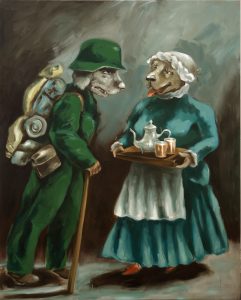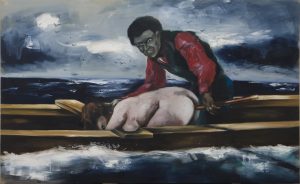I first discovered Forstner at the Hong Kong Art Fair. Galerie Zink of Munich and Berlin was representing him. As it was shocking for me to encounter his paintings, I decided to interview him to gain a better understanding of the inspiration behind his work.
First of all, I notice that you are half-French and half-Austrian. You were born in Cameroon. You grew up in Cameroon and Europe. Now, you live in New York. Has the experience of living in different places affected your art?
It’s hard to say. There’s this romantic thing we all have that for an artist if you are moving from place to place it should somehow influence the work. Actually I kind of like the idea, and it must get into the work somehow but it’s difficult to say how it affects the work exactly. For sure it has opened my mind, I’ve gathered many different sensations according to where I lived.
Also I never felt either French or Austrian though I do feel quite European culturally speaking. Now I live in Bed-Stuy-Brooklyn and I feel more comfortable here than in Paris for example or Vienna. By moving, you get the chance to approach the same things from a different angle, you adapt yourself.
I am now perusing your book, The Ship of Fools. The series “The Departure and The Waiting Room” surround viewers with green uniformed human dogs. I associate the dogs with Nazi soldiers. I also see them as soldiers in other wars, such as Serb soldiers in the war with Bosnia. Why did you employ dogs to symbolize the soldiers? Honestly, if I were you, I would use wolves to represent the soldiers, since generally by nature, wolves are more brutal than dogs.
Dogs in my work don’t especially represent soldiers, as I also used them to depict other behaviors or sensations. Dogs are easier to use because culturally speaking they have already a history of caricatures in newspapers and journalism, Churchill for example would be the Bulldog etc. So the unconsciousness of the viewer relates to it instantly.
Dogs are closer to our domestic image than wolves, and therefore more interesting for me. In my work, they come from these popular illustrations from Sarnoff and Coolidge of dogs playing pool or poker that you can find in all the game clubs worldwide. I used to play pool myself to relax and was surrounded by those illustrations, I became fascinated by them because they looked really dumb and very precise in the same time, like caricatures in general.
Then they appeared to me as contemporary scenes of 17th century painters that I’m very fond of, such as Frans Hals, Jan Steen, Adrian Brouwer (etc) from the Netherlands – depicting human behaviors in taverns, domestic environment and painting for the bourgeoisie of the time.
As I was fascinated by those illustrations, I decided to copy one for myself as a kid would do when he likes an image but cannot get the original. So I did it in a huge scale – it’s now part of the collection of the Fonds National d’Art Contemporain in Paris.
Then, it all started from a joke at the studio: “What should I do next now that I have made this image mine? OK! They’re going to beat the shit out of them! It will become a freewheel play, a sort of playground where no moral judgement will interfere! I’m a painter, not a soldier. I’m a lucky guy, I don’t kill to make a living, I make paintings!”

Nevertheless, there came massacre scenes, but with joyful feelings, the pool sticks became weapons, etc. I wanted to do something that was both an enjoyable and monstrous event for the viewer. He could have the guilt of laughing or being entertained at something there’s nothing to laugh about or be entertained with.
With “The Departure and The Waiting Room,” what would you like to tell the public through the characters in the works including soldiers, victims wearing gas masks, hangmen and Nazi soldiers in skull bones?
I don’t think a painter makes a painting to tell anything to anyone. I have a sensation, I try to find ways to objectify this sensation. Hopefully while painting, I find a new sensation I wasn’t aware of and if I’m lucky the viewer finds something that is meaningful to him also.
My work, generally speaking, is about absurdity. I’m painting because I don’t understand what I’m doing on Earth. When I was a child I had an image of God laughing while looking at us from above. Long after that early sensation, I found in the laughter of Democritus the same feeling of absurdity regarding human activity. With my “Nazi Dogs”, people might get stuck to the war thing and not go further, but that’s the game, there are always different ways to look at things.
Those paintings for me are about my feelings for my father (“The departure- Oedipus at work, 2008”, “The ship of Fools-Father and son going fishing, 2009”), or the blanks left by my family about my grandfather who was in the SS, as I have very litltle information. They are also a tribute to the generation of Baselitz, Lupertz, the Café Deutschland of Immendorf, for example.
Furthermore, it’s also depicting the human tragedy in a very classic way as it is the case in the Greek mythology. Humor is always there in the work, but you know, sometimes I find one of my paintings “funny” and someone else finds it tough or doesn’t get the point. Of course, I play with those issues consciously, knowing some misunderstanding might arise.
I‘m always suspicious when everyone agrees on a painting, whether they like it or not, I like to keep the doubt in the viewer’s head so that he has to go back and forth to make up his mind.
You appear to be interested in Nazi legacy. Do you try to deal with your family history through depicting the crimes of Nazis?
I’m not particularly interested in Nazi legacy. Basically, it interests me like anyone else, not much more. But my grandfather was a SS officer, so I grew up with his pictures, the stories or the lack of stories surrounding him, plus my grandmother used to tell me I looked more like him than my father did.
Being a kid, I was quite proud somehow, because he looked good in those propaganda Nazi black and white photos with “Blick am west”! I cannot ignore all this as an artist. But you know for a German or Austrian grandson of today, there’s nothing exceptional to have a Nazi grandfather, uncle, and so on, in the family.
I’m an artist, so it came into the work without me looking for it, almost by “mistake.” Unlike Baselitz, Lüpertz or Immendorf, I’m the third generation dealing with those issues. I never felt the so-called guilt like the generation of my father.
Somehow these artists were pushed by history to make something out of it to survive as artists, social persons, they were born with it, and that’s how it became understandable, acceptable and acclaimed. I have a great respect for those artists, they did something very important. On my side I cannot justify those paintings the same way, plus I put humor into it, which is for some people not acceptable or not well understood.
The point is the themes of these paintings are not just Germany or war in general, but they work as shared entries of cultural and historical acknowledgment, through which I try to create a specific sensation. It’s a common history from which a certain relation to the world asserts and questions itself, especially through memories and history told by “fathers”. It is, amongst other things, a principle of transmission and interpretation, it is questioning the way a subject creates itself from this memory.
And most of the time, the subject only has a remote and anecdotal connection with that memory. Generally speaking I try to set up things in a way that the viewer wants to know more about the mystery within the paintings, but I’m also interested in the same time to have the viewer experience the subject with the possibility that there would be nothing beyond, nothing really but just the fact that painting this or that is already an event by itself.
What are your current projects?
Right now, I’m participating in two group shows, one at Parker’s Box gallery in Brooklyn (“Ten years Hunting”) and another one at Thomas Rehbein galerie in Cologne – “Liaisons Dangereuses” curated by Ludwig Seyfarth who wrote an essay of my work in the catalogue “The Ship of Fools”-Musée de Grenoble-2009.
Recently I’ve been I’m working on a new body of work with a new archetype: “The Happy Fisherman.” I guess these works could be called allegorical. A black fisherman dressed up to go to church and not fishing for fish; instead of having fishing gears, he still has those sticks to play pool from the previous paintings, as if they were still lying on the floor of my studio ready to be picked up and placed in the new paintings. He uses those sticks to play with women like the dogs were fooling around before. The humor is still there and I play with stereotypes, though because there are no puppets anymore, it’s less obvious, the image is more direct, you can’t escape from it.
When I talk about humor, I see it as the contradiction of different feelings and not necessarily as something just “funny.” When one is so used to think of a work of art with certain common criteria of today, you need to give the paintings some time so that the layers unfold one after the other to allow a more open, genuine approach. Painting is about time!
In these paintings, I deal with sexuality but without complacency vis-à-vis the viewer unlike porn would do. If there is seduction it must be because the painting is good not because there’s a naked woman or you can see an ass or a dick. It’s always about contrary feelings, once again, I want to install a doubt in the viewer’s head.

Something unbearable, monstrous is something that is detached from its original environment and thrown into an environment where it doesn’t belong. Monstrosity only exists from a point of view, not by itself. Monstrosity cannot be detached from fascination; as a painter and image maker, it’s very interesting to me.
The transition is “The Ship of Fools” theme, where the landscape, the sea and the boat going nowhere were already there. “The Happy Fisherman” stands like a new archetype in my work taking the place of the fools and dogs, the first related “American archetype” after I came to the USA, I believe. Maybe, as you suggested, geography has started to influence the work!

One thought on “Inspired by Nazi horror: an interview with Gregory Forstner”
Comments are closed.